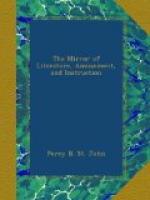LILLIARD EDGE.
(For the Mirror.)
Near the border between the parishes of Maxton and Ancrum is a bridge, called Lilliard Edge, formerly Anerum moor, where a battle was fought between the Scots and English soon after the death of king James V., who died in the year 1542. When the Earl of Arran was regent of Scotland, Sir Ralph Rivers and Sir Bryan Laiton came to Jedburgh with an army of 5,000 English to seize Merse and Teviotdale in the name of Henry VIII., then king of England, who died not long after, in the year 1547. The regent and the Earl of Angus came with a small body of men to oppose them. The Earl of Angus was greatly exasperated against the English, because some time before they had defaced the tombs of his ancestors at Melrose, and had done much hurt to the abbey there. The regent and the Earl of Angus, without waiting the arrival of a greater force, which was expected, met the English at Lilliard Edge, where the Scots obtained a great victory, considering the inequality of their number. A young woman of the name of Lilliard fought along with the Scots with great courage; she fell in the battle, and a tombstone was erected upon her grave on the field where it was fought. Some remains of this tombstone are still to be seen. It is said to have contained the following inscription:—
“Fair maiden Lilliard lies under
this stane;
Little was her stature, but great was
her fame.
On the English lads she laid many thumps,
And when her legs were off she fought
on her stumps.”
T.S.W.
* * * * *
BOOKS AND BOOKWORMS.
(For the Mirror.)
Books were anciently made of plates of copper and lead, the bark of trees, bricks, Stones, and wood. Josephus speaks of two columns, the one of stone, the other of brick, on which the children of Seth wrote their inventions and astronomical discoveries. Porphyry mentions some pillars, preserved in Crete, on which the ceremonies observed by the Corybantes in their sacrifices were recorded. The leaves of the palm-tree were used, and the finest and thinnest part of the bark of such trees as the lime, the ash, the maple, and the elm; from hence comes the word liber, which signifies the inner bark of the trees; and as these barks are rolled up, in order to be removed with greater ease, these rolls were called volumen, a volume, a name afterwards given to the like rolls of paper or parchment. By degrees wax, then leather, were introduced, especially the skins of goats and sheep, of which at length parchment was prepared; also linen, then silk, horn, and lastly paper. The rolls or volumes of the ancients were composed of several sheets, fastened to each other, rolled upon a stick, and were sometimes fifty feet in length, and about a yard and a half wide. At first the letters were only divided into lines,




